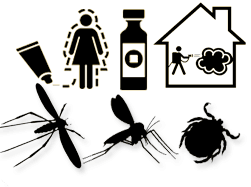The theme of World Health Day 2014 is vector-borne diseases, under the slogan "Small bite: big threat".
What are vectors?
Vectors are small organisms that carry diseases and spread them from person to person and place to place. They can put our health at risk, at home and when we travel.
Why vector-borne diseases ?
Every year more than one million people die from vector-borne diseases, such as malaria, dengue, schistosomiasis, leishmaniasis and yellow fever. Many more people are left with chronic illness and disabilities as a result of infection.
More than half the world’s population is at risk of these diseases. Increased travel, trade and migration is increasing the number of people at risk.
Vector-borne diseases cause immense suffering for millions of people.
Not only do these diseases have a profound effect on people’s health but they are a serious impediment to poverty reduction and socioeconomic development.
It is time to draw global attention to the threat posed by vectors and vector-borne diseases.
World Health Day 2014 is an event to draw global attention to these threats.
Media campaign
 Take simple measures to protect yourself from vector-borne diseasesThe 2014 campaign will highlight some of the most commonly known vectors – such as mosquitoes, sandflies, bugs, ticks and snails – responsible for transmitting a wide range of parasites and pathogens that attack humans or animals.
Take simple measures to protect yourself from vector-borne diseasesThe 2014 campaign will highlight some of the most commonly known vectors – such as mosquitoes, sandflies, bugs, ticks and snails – responsible for transmitting a wide range of parasites and pathogens that attack humans or animals.
Overall goal
The campaign aims to raise awareness of the threat posed by vectors and vector-borne diseases and to encourage families and communities to take action to protect themselves. As vector-borne diseases begin to spread beyond their traditional boundaries, action needs to be expanded beyond the countries where these diseases currently thrive.
Objectives and target audiences
The public health objectives of the campaign are to ensure that:
families living in areas where diseases are transmitted by vectors know how to protect themselves;
travellers know how to protect themselves from vectors and vector-borne diseases when travelling to countries where these pose a health threat;
in countries where vector-borne diseases are a public health problem, ministries of health put in place measures to improve the protection of their populations; and
in countries where vector-borne diseases are an emerging threat, health authorities work with environmental and relevant authorities locally and in neighbouring countries to improve integrated surveillance of vectors and to take measures to prevent their proliferation.
Key messages
Mosquitoes, flies, ticks, bugs and freshwater snails can spread diseases that cause serious illness and death.
Diseases such as malaria, dengue, leishmaniasis and yellow fever are preventable, yet they have the biggest impact on some of the world’s poorest people.
More than half of the world’s population is at risk of these diseases. Increased travel, trade and migration make even more people vulnerable.
You can protect yourself and your family by taking simple measures that include sleeping under a bednet, wearing a long-sleeved shirt and trousers and using insect repellent.


